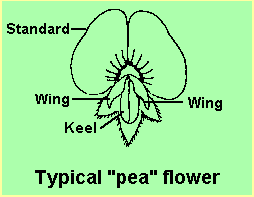General Description:
The genus Templetonia is a small genus of 8 species, all of which occur only within Australia. They are small to medium shrubs.
Templetonia retusa is a shrub from 1 to 2 metres in height often with an upright habit of growth. The leaves are greyish green, oblong to wedge-shaped, usually with a blunt, indented tip. They bare 15-40 mm long and 7-25 mm wide.

The flowers are quite large, from 25 to 40 mm long and have the typical “pea” shape consisting of 4 petals; the “standard”, the “keel” and two “wings”, as shown in the diagram. They are usually a deep red in colour but white and yellow flowered forms are known. They are seen in winter to spring over a fairly long period. The flowers are attractive to honey-eating birds and are followed by linear-oblong seed pods about 40-50 mm long by 10 mm wide.
Templetonia retusa has been in cultivation for many years and it is an attractive and hardy plant suited to a range of climates. Despite its natural habitat in a dry Mediterranean climate, it has proved to be reliable in the more humid temperate climates of the east coast. It requires well drained soils in sun or semi-shade and tolerates at least moderate frost.
Propagation is easy from seed following pre-treatment to break the physical dormancy provided by the impervious seed coat. Pre-treatment can be carried out by abrasion or by the use of boiling water (further details can be found in under the “Propagation” tab of the “Pea Family” page). The seed retains viability for many years. Cuttings are also successful using firm, current season’s growth.

Templetonia retusa
Photo: Brian Walters
 Australian Native Plants Society (Australia)
Australian Native Plants Society (Australia)